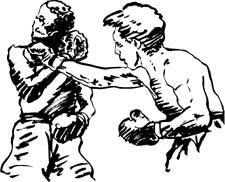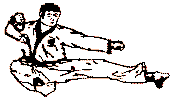|
Physical Training of a Martial ArtPhysical Training -Learn how you can improve your Abilities by thoroughly understanding your goals, and how to achieve them...

The physical training of a martial art is one of three components which any complete martial art attains. We examined thoroughly this overview in our main page. We will try to address this vast subject by using our analyzing tools: Conception – Strategy – Tactic – Technique – C.S.T.T. Theory of C-S-T-T Let’s try to simplify the subject by thinking of the martial art essence – to win!! Meaning lets look at the martial art as a fighting art. Thinking of physical training we must first imagine and build, in our mind, the features of our "ultimate warrior": Agile, flexible, strong, powerful, high endurance, great stamina, good reflexes, fast, coordinated and much more… If we had 24 hours each day, just for physical training, maybe we could achieve the improvement required in all of these categories. But the fact of the matter is – we don’t!! Like everything in life we need to define what is more advancing and what is less towards achieving our goals. Physical training in a martial art is not different. We have to be economical in our training regime; we have to train efficiently to get the best results for the time put in!! And for that we need to first, Evaluate the importance of each physical component to our end result!! We will try to examine some attributes: What we’re going to check are some key physical components which we will evaluate according to a specific martial art: AgilityThe power of moving quickly and easily – The ability to move and change position
It would be hard for us to imagine a martial art which doesn’t need agility, but agility comes in different forms and importances depanding on the martial art: Boxing – In boxing there are two main components which need to be agile • Back/ Upper body • Legs – The legs need to reposition the whole body structure at a very high changing pace. Back/Upper body - In boxing, more than in any other striking art, the upper body and back work extra fast and hard. This is due to several technical reasons.
- Boxing uses big gloves – In order to affect our opponent with our punch we have to produce tremendous striking power, we do this not only by utilizing our hand power, hip rotation speed and full body movement, but also by using our upper body. - Boxing does not permit takedowns and the fight ends with a knock out - Because of this, we can afford to “throw every thing we have” into a punch (it’s an exaggeration but just to make a point), because we have a lot less to lose if we miss – We cannot be taken down, and “even” if we get knocked unconscious, unlike in a street fight, we know it will not have life and death implications… - Boxing does not permit leg strikes - Because we are not exposed to leg strikes we can allow our selves to take a very low and bent posture with our upper body. - Boxing defense concept and technique – In boxing we use our upper body agility to avoid attacks , a quick slip, many times, is our most preferred technique for avoiding an attack (if it can be turned into a counter punch straight off all the best and if right after the slip also good). This position allows us to be in a good position to deliver an attack with either hands (contrary to a block/deflection which usually leaves us with only one hand for the next attack), but this when done in an "extreme fashion" sometimes common in boxing, prevents us from quickly mobilizing our legs for a leg strike. Leg agility - Used to mobilize our whole body. This also is a result based on the demands of the fighting art. In boxing we don’t need to be time efficient, sometimes even, we must be able to waste time. Unlike in street fights where time is a very important factor. In the boxing ring we have time to move around and pick our best moments. Don't get us wrong, in street fighting we also need good leg agility! But from the "physical training" perspective, we would not put the same effort in training it as we would when preparing for a boxing match (or as a boxer)
Brazilian jiu-jitsu, Sambo – Probably the most agility demanding, all around, martial arts. Why? Because we need good agility in all body parts. Any part, legs, neck, head, shoulder elbow…. Any thing that can touch the mat, or get caught by a lock or choke, needs to be able to move with ease and strength sometimes with the opponents whole weight on top… ! On the other hand, especially when on the ground, the agility doesn’t have to be as quick, as in stand up fighting, or as in mma fighting because strikes are not involved. The speed of the strike itself is much quicker then the lock… therefore the drills used for developing and improving these qualities will not and should not be the same. Warrior with armor or combat soldier full geared (the gear can easily add up to 20-40 pounds) – Having extra weight when fighting, forces us to bring many issues under consideration while deciding which physical components to train. The concepts, strategies, tactics and techniques, must be coordinated in order to over come these sorts of boundaries. Although having extra agility is never bad (especially when it comes to moving around with the armor) it would be more relevent to first focus on the physical strength needed to hold and strike with the sword, spear or assault rifle and the stamina needed to fight with such weight for comparatively a long time (battles are not measured in minutes…).
StaminaBoxing, kick boxing, mma – stamina in these martial arts is of the at most importance, and is an essential part of our physical training. The fact that the fight can last for so long, and with such intensity, make these “sports” to be some of the most demanding if not the most demanding of any sports - cardio wise. Nevertheless we need to consider our choice of drills. We wouldn’t work with the same exercises, as for instance, a basketball player would use inorder to improve stamina. Even between the martial arts listed above, we would need to differentiate the stamina training in our phyical training, because of different conditioning demands cardio and muscle wise… Street fighting - In a street fight, because of its tendency to end quickly, one way or the other, we wouldn’t devote much of our time to cardio exercises. Although in a street fight there's a tendency to get very tired fast (even before the fight starts), this is usually due to mental difficulties – stress, fear, anger and so on.. To learn more about Stamina in a Martial Art StrengthGrappling, wrestling – One of the most important features we need as grapplers is our sheer strength, training weights, for example, can imitate accurately the sort of muscles we will use in the fight. Kick boxing, street fighting or any striking martial art – these arts are based on their power rather on their strength (for more information go to the power of kicks and punches) In general the power of a strike is: [m×v²]\2. Meaning that the majority of the striking power comes from the v – velocity. As we know abundance of muscle contributes to speed loss. The extra muscle mass does have its advantages – it supports the mass component of the equation, but remember we’re thinking economically. Therefore it’ll be more efficient to put more time in other physical training’s, which are more important for the striking martial arts. MMA – As mma fighters we have our work cut out for us. Because of the characteristics of this martial art, we have many things we must be good at. If to compare it to the Olympics – The mma fighters are the decathlon athletes (the striker would probably be the sprinter, and the grappler wrestler would be the iron ball thrower..) As mma fighters we definitely need to develop our strength, especially if we want to utilize throwing and taking down components, but not at the same extent as the pure wrestlers. Av course, even, as mma fighters we can choose which fighting style, strategy and technique to apply. We can decide to concentrate, for instance, on our striking. Examples of such fighters are Chuck Liddel (Great knockout power in both hands), Lyota Machida and many more. Brazilian jiu-jitsu – Developing strength in this martial art is very important.. But too much muscle in this martial art can be a big disadvantage if even a little over done, it reduces the agility and the flexibility needed to excel. Sambo – Developing strength in this martial art is also very important. But unlike its Brazilian brother, here strength in the form of muscle, is not as harmful. This is all derived from the fact that there is a difference in strategy and techniques between these fighting methods (More on types of martial arts). Knife fighting, and cold weapon fighting – There is almost no strength training needed in these martial arts, because the weapon itself does the damage and it does it without the need for us to apply much power or strength
Physical enduranceAlthough this and mental endurance are most of the time referred to as one, there’s no question, that the physical part of the endurance must be addressed as a factor on its own. A person attempting to break a brick, without practicing it before is more then likely to break his hand on the attempt, and a boxer trying to defend a muai-tai low kick with his leg for the first time is likely to have it hurt or stiffen up so bad that he would not be able to use it… Boxing – In general we concentrate our physical endurance training on upper body shots, and head shots. There is no need to train hand or leg endurance – First of all we don’t block strikes with them aside from with our gloves and shoulder. Secondly, we get hit with a glove, which lowers the chances of muscle stiffening… Karate – This martial art has probably perfected the element of physical endurance to it’s peak In this art we utilize blocking with every part of the body.
Conclusions & Moving forwardWe could probably go on and on, examining much more physical training aspects of the martial arts, but the main idea is clear. We will deepen the knowledge and specify it in the following sections. More on physical training elements as the site progresses: • Stamina • Strengthening • Power • Bone and Muscle Development • Agility, Speed and Quickness • Martial Arts Exercises
Not everyone uses the martial arts for fighting; or at least “winning the fight” is not their primary goal, in which case the way we build the physical training program depends on our specific needs and wants.. Aside from giving specific tips for physical training methods and drills, we (the warriors project), also recommend for you to read the sections which concern: Warm-ups, injuries,physiotherapy, chi-gung, massage, acupuncture health tips and treatments (when these sections will be added) which will complete the overall picture of the physical training in a martial art.
Learn great new strengthening exercises
Go from Physical Training to Martial Arts Techniques Training Return from Physical Training to the Homepage |
